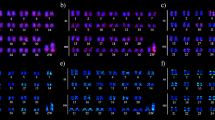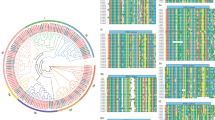Abstract
Sox genes encode a family of transcription factors with important roles in metazoan development, including sex-determination, embryogenesis, neurogenesis, and skeletogenesis. We identified Sox genes in the Bombyx mori genome and characterized their evolution and expression patterns. Nine Sox genes were annotated, and could be classified into five groups, B–F. Four Sox genes in the B group were tandemly clustered on one chromosome, a characteristic common to their orthologs in other insects. The intron number in the high-mobility group (HMG) box of Sox genes exhibited low diversity across surveyed insects. Based on 40 different silkworm variety genomes, we found a similar number of single nucleotide polymorphisms (SNPs) in the coding sequences of each Sox gene, for domesticated and wild groups. However, a gene-based examination showed that SoxB3 and SoxD might be evolving under positive selection during silkworm domestication. Phylogenetic analysis showed that SoxC, SoxD, and SoxF originated before the radiation of insects, and groups B and E evolved through gene duplication after the radiation of insects. Furthermore, BmSox21a, BmSoxB3,BmSoxD, and BmSoxE reveal stage, tissue, or sex-dependent expression patterns. These results provide a foundation for further surveying the functions of Sox genes during silkworm development and domestication.






Similar content being viewed by others
References
Gubbay J, Collignon J, Koopman P, Capel B, Economou A, Munsterberg A, Vivian N, Goodfellow P, Lovell-Badge R (1990) A gene mapping to the sex-determining region of the mouse Y chromosome is a member of a novel family of embryonically expressed genes. Nature 346(6281):245–250
Harley VR, Lovell-Badge R, Goodfellow PN (1994) Definition of a consensus DNA binding site for SRY. Nucleic Acids Res 22(8):1500–1501
Wegner M (2009) All purpose Sox: the many roles of Sox proteins in gene expression. Int J Biochem Cell Biol. doi:10.1016/j.biocel.2009.07.006
Phochanukul N, Russell S (2009) No backbone but lots of Sox: invertebrate Sox genes. Int J Biochem Cell Biol. doi:10.1016/j.biocel.2009.06.013
Koopman P (2005) Sex determination: a tale of two Sox genes. Trends Genet 21(7):367–370
Barrionuevo F, Scherer G (2009) SOX E genes: SOX9 and SOX8 in mammalian testis development. Int J Biochem Cell Biol. doi:10.1016/j.biocel.2009.07.015
Nanda S, DeFalco TJ, Loh SH, Phochanukul N, Camara N, Van Doren M, Russell S (2009) Sox100B, a Drosophila group E Sox-domain gene, is required for somatic testis differentiation. Sex Dev 3(1):26–37
Raverot G, Weiss J, Park SY, Hurley L, Jameson JL (2005) Sox3 expression in undifferentiated spermatogonia is required for the progression of spermatogenesis. Dev Biol 283(1):215–225
Mukherjee A, Melnattur KV, Zhang M, Nambu JR (2006) Maternal expression and function of the Drosophila sox gene Dichaete during oogenesis. Dev Dyn 235(10):2828–2835
Chao AT, Jones WM, Bejsovec A (2007) The HMG-box transcription factor SoxNeuro acts with Tcf to control Wg/Wnt signaling activity. Development 134(5):989–997
Russell SR, Sanchez-Soriano N, Wright CR, Ashburner M (1996) The Dichaete gene of Drosophila melanogaster encodes a SOX-domain protein required for embryonic segmentation. Development 122(11):3669–3676
Soriano NS, Russell S (1998) The Drosophila SOX-domain protein Dichaete is required for the development of the central nervous system midline. Development 125(20):3989–3996
Sandberg M, Kallstrom M, Muhr J (2005) Sox21 promotes the progression of vertebrate neurogenesis. Nat Neurosci 8(8):995–1001
Bergsland M, Werme M, Malewicz M, Perlmann T, Muhr J (2006) The establishment of neuronal properties is controlled by Sox4 and Sox11. Genes Dev 20(24):3475–3486
Stolt CC, Wegner M (2009) SoxE function in vertebrate nervous system development. Int J Biochem Cell Biol. doi:10.1016/j.biocel.2009.07.014
Nambu PA, Nambu JR (1996) The Drosophila fish-hook gene encodes a HMG domain protein essential for segmentation and CNS development. Development 122(11):3467–3475
Kondoh H, Uchikawa M, Kamachi Y (2004) Interplay of Pax6 and SOX2 in lens development as a paradigm of genetic switch mechanisms for cell differentiation. Int J Dev Biol 48(8–9):819–827
Dichtel-Danjoy ML, Caldeira J, Casares F (2009) SoxF is part of a novel negative-feedback loop in the wingless pathway that controls proliferation in the Drosophila wing disc. Development 136(5):761–769
Lefebvre V, Dumitriu B, Penzo-Mendez A, Han Y, Pallavi B (2007) Control of cell fate and differentiation by Sry-related high-mobility-group box (Sox) transcription factors. Int J Biochem Cell Biol 39(12):2195–2214
Guth SI, Wegner M (2008) Having it both ways: Sox protein function between conservation and innovation. Cell Mol Life Sci 65(19):3000–3018
Koopman P, Schepers G, Brenner S, Venkatesh B (2004) Origin and diversity of the SOX transcription factor gene family: genome-wide analysis in Fugu rubripes. Gene 328:177–186
Schepers GE, Teasdale RD, Koopman P (2002) Twenty pairs of sox: extent, homology, and nomenclature of the mouse and human sox transcription factor gene families. Dev Cell 3(2):167–170
Cremazy F, Berta P, Girard F (2001) Genome-wide analysis of Sox genes in Drosophila melanogaster. Mech Dev 109(2):371–375
Wilson MJ, Dearden PK (2008) Evolution of the insect Sox genes. BMC Evol Biol 8:120
Bowles J, Schepers G, Koopman P (2000) Phylogeny of the SOX family of developmental transcription factors based on sequence and structural indicators. Dev Biol 227(2):239–255
Shinzato C, Iguchi A, Hayward DC, Technau U, Ball EE, Miller DJ (2008) Sox genes in the coral Acropora millepora: divergent expression patterns reflect differences in developmental mechanisms within the Anthozoa. BMC Evol Biol 8:311
Goldsmith MR, Shimada T, Abe H (2005) The genetics and genomics of the silkworm, Bombyx mori. Annu Rev Entomol 50:71–100
International Silkworm Genome Consortium (2008) The genome of a lepidopteran model insect, the silkworm Bombyx mori. Insect Biochem Mol Biol 38(12):1036–1045
Mita K, Kasahara M, Sasaki S, Nagayasu Y, Yamada T, Kanamori H, Namiki N, Kitagawa M, Yamashita H, Yasukochi Y et al (2004) The genome sequence of silkworm, Bombyx mori. DNA Res 11(1):27–35
Xia Q, Zhou Z, Lu C, Cheng D, Dai F, Li B, Zhao P, Zha X, Cheng T, Chai C et al (2004) A draft sequence for the genome of the domesticated silkworm (Bombyx mori). Science 306(5703):1937–1940
Xia Q, Guo Y, Zhang Z, Li D, Xuan Z, Li Z, Dai F, Li Y, Cheng D, Li R et al (2009) Complete resequencing of 40 genomes reveals domestication events and genes in silkworm (Bombyx). Science 326(5951):433–436
Duan J, Li R, Cheng D, Fan W, Zha X, Cheng T, Wu Y, Wang J, Mita K, Xiang Z et al (2010) SilkDB v2.0: a platform for silkworm (Bombyx mori) genome biology. Nucleic Acids Res 38(Database issue):D453–D456
Altschul SF, Madden TL, Schaffer AA, Zhang J, Zhang Z, Miller W, Lipman DJ (1997) Gapped BLAST and PSI-BLAST: a new generation of protein database search programs. Nucleic Acids Res 25(17):3389–3402
Yamamoto K, Nohata J, Kadono-Okuda K, Narukawa J, Sasanuma M, Sasanuma SI, Minami H, Shimomura M, Suetsugu Y, Banno Y et al (2008) A BAC-based integrated linkage map of the silkworm Bombyx mori. Genome Biol 9(1):R21
Yang Z (1997) PAML: a program package for phylogenetic analysis by maximum likelihood. Comput Appl Biosci 13(5):555–556
Sackton TB, Lazzaro BP, Schlenke TA, Evans JD, Hultmark D, Clark AG (2007) Dynamic evolution of the innate immune system in Drosophila. Nat Genet 39(12):1461–1468
Storey JD, Tibshirani R (2003) Statistical significance for genomewide studies. Proc Natl Acad Sci USA 100(16):9440–9445
Yang Z, Nielsen R, Goldman N, Pedersen AM (2000) Codon-substitution models for heterogeneous selection pressure at amino acid sites. Genetics 155(1):431–449
Marchler-Bauer A, Bryant SH (2004) CD-Search: protein domain annotations on the fly. Nucleic Acids Res 32(Web Server issue):W327–W331
Thompson JD, Gibson TJ, Plewniak F, Jeanmougin F, Higgins DG (1997) The CLUSTAL_X windows interface: flexible strategies for multiple sequence alignment aided by quality analysis tools. Nucleic Acids Res 25(24):4876–4882
Tamura K, Dudley J, Nei M, Kumar S (2007) MEGA4: molecular evolutionary genetics analysis (MEGA) software version 4.0. Mol Biol Evol 24(8):1596–1599
Nagy L, Riddiford L, Kiguchi K (1994) Morphogenesis in the early embryo of the lepidopteran Bombyx mori. Dev Biol 165(1):137–151
Ueno K, Nagata T, Suzuki Y (1995) Roles of homeotic genes in the Bombyx body plan. In: Molecular model systems in the lepidoptera. Cambridge University Press, Cambridge pp 165–180
Barrett T, Edgar R (2006) Gene expression omnibus: microarray data storage, submission, retrieval, and analysis. Methods Enzymol 411:352–369
Xia Q, Cheng D, Duan J, Wang G, Cheng T, Zha X, Liu C, Zhao P, Dai F, Zhang Z et al (2007) Microarray-based gene expression profiles in multiple tissues of the domesticated silkworm, Bombyx mori. Genome Biol 8(8):R162
Clark AG, Eisen MB, Smith DR, Bergman CM, Oliver B, Markow TA, Kaufman TC, Kellis M, Gelbart W, Iyer VN et al (2007) Evolution of genes and genomes on the Drosophila phylogeny. Nature 450(7167):203–218
McKimmie C, Woerfel G, Russell S (2005) Conserved genomic organisation of Group B Sox genes in insects. BMC Genet 6(1):26
Okuda Y, Yoda H, Uchikawa M, Furutani-Seiki M, Takeda H, Kondoh H, Kamachi Y (2006) Comparative genomic and expression analysis of group B1 sox genes in zebrafish indicates their diversification during vertebrate evolution. Dev Dyn 235(3):811–825
Argenton F, Giudici S, Deflorian G, Cimbro S, Cotelli F, Beltrame M (2004) Ectopic expression and knockdown of a zebrafish sox21 reveal its role as a transcriptional repressor in early development. Mech Dev 121(2):131–142
DeFalco TJ, Verney G, Jenkins AB, McCaffery JM, Russell S, Van Doren M (2003) Sex-specific apoptosis regulates sexual dimorphism in the Drosophila embryonic gonad. Dev Cell 5(2):205–216
Chaboissier MC, Kobayashi A, Vidal VI, Lutzkendorf S, van de Kant HJ, Wegner M, de Rooij DG, Behringer RR, Schedl A (2004) Functional analysis of Sox8 and Sox9 during sex determination in the mouse. Development 131(9):1891–1901
Acknowledgments
We thank anonymous referees for providing valuable comments. This work was supported by grants from the National Basic Research Program of China (No. 2005CB121000), the National Natural Science Foundation (No. 30771630 and No. 30972146), the Fundamental Research Funds for the Central Universities (XDJK-2009C145), the Program for Changjiang Scholars and Innovative Research Team in University (No. IRT0750), and the Programme of Introducing Talents of Discipline to Universities (No. B07045).
Author information
Authors and Affiliations
Corresponding authors
Rights and permissions
About this article
Cite this article
Wei, L., Cheng, D., Li, D. et al. Identification and characterization of Sox genes in the silkworm, Bombyx mori . Mol Biol Rep 38, 3573–3584 (2011). https://doi.org/10.1007/s11033-010-0468-5
Received:
Accepted:
Published:
Issue Date:
DOI: https://doi.org/10.1007/s11033-010-0468-5




